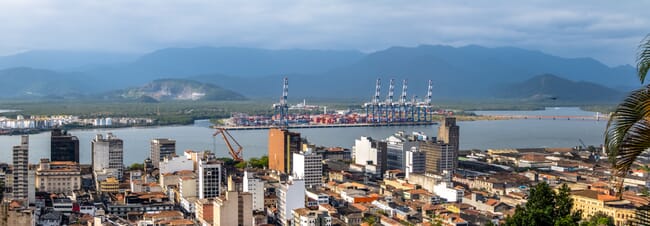Researchers affiliated with the Federal University of São Paulo (UNIFESP) and the University of New South Wales (UNSW) in Sydney, found a direct correlation between the degree of urbanisation, contamination of the sea by metals and the possible metabolic stress caused by these contaminants in mussels that live on the beaches of interest. The study was funded by São Paulo Research Foundation (FAPESP) and published in Marine Pollution Bulletin.
According to a press release from FAPESP the group collected samples of Mytilaster solisianus, which inhabits these six beaches in large clumps by clinging to wave-washed intertidal rocks. This species is not consumed by humans. However, like others that are consumed and hence are economically significant, this species filters the seawater around it to extract and absorb oxygen and edible particles. As a result, it is vulnerable to contamination.

Specimens were collected from Guaiúba, Astúrias, Morro do Maluf, Mar Casado, Sorocotuba and Iporanga beaches. Analysis of the specimens showed, as expected, that the filtration performed by the mussels increased when the water contained a high concentration of particles. In contrast to studies conducted by other groups, however, this group found that filtering also intensified when the water contained few edible particles and high levels of copper, nickel and zinc.
These three metals are chemically similar and cannot be differentiated in a shellfish contamination analysis. Copper is known to have detrimental effects on a range of organisms, which explains the researchers' interest in this three-metal group.
However, the mussels' behaviour remained unaltered when they were exposed to particles of iron and manganese.
"They may have been under metabolic stress, seeking more food and making gas exchanges in an effort to recoup the energy lost by trying to eliminate pollutants," said Professor Ronaldo Christofoletti from UNIFESP's Institute of Marine Sciences (IMar), who was one of the article’s authors.
Follow-up
Aline Sbizera Martinez, a postdoctoral researcher at IMar-UNIFESP with a scholarship from FAPESP, is now conducting new tests that include measures of excretion and respiration as well as filtration rates.
"More stress makes these animals filter, excrete and breathe more intensely," Martinez said. "By measuring these rates, we can calculate what we call scope for growth, basically an indicator of the amount of energy left over for the animal to grow. We plan to use these metrics to find out whether the copper, nickel and zinc group is actually having a physiological effect on the mussels."
In the published study, the researchers also measured the biomass of the macrofauna associated with mussel colonies - barnacles, algae, worms and so on that feed on the mussels' feces. Although mussels excrete more when they are exposed to metals, given that they must also filter and feed more intensely, contamination did not alter the biomass of the associated macrofauna. The researchers now plan to see if contamination affects the macrofauna's species diversity.
Differences
One of the differences between the currently published study and the research conducted previously by other groups resided in the experimental methods used to measure the mussels' filtration. Previous studies, which observed a reduction in filtration when the environment contained metal particles, were performed in the laboratory with animals collected from relatively clean areas and submitted to varying amounts of metal particles. In contrast, the UNIFESP group's experiments were conducted at the collection sites themselves.
"These studies conveyed the idea that filtration decreases when levels of pollutants increase, but when we performed our experiments in the field, in the environment where these animals live, filtration increased even when contamination levels were high," Christofoletti said.
In their experiments, the researchers placed approximately 100 cm² of mussels in a bucket with four litres of water from the collection site and measured the quantity of particles present in the water twice - once immediately after the mussels were placed in the bucket and again one hour later.
The difference between the two measurements was considered equivalent to the quantity of particles retained by the mussels.
"In our experiments, we analysed animals that lived in the environment at the site and used the water they actually lived in," Christofoletti explained. "They had adapted to higher levels of particles of these metals. Collecting them from a pristine area and later adding the metals would be a major shock to their metabolism. You would expect them to stop filtering initially."
The copper-nickel-zinc group is abundant in the Santos Bay area in part because of the Port of Santos, the largest port in Latin America. One of the main sources of these metals is the anti-fouling paint used to prevent barnacles and other aquatic organisms from attaching themselves to ships' hulls.
Santos Bay and the coastal plain south of the city (known as Baixada Santista) also contain one of Brazil's largest industrial clusters, as well as a large region characterised by urban sprawl, with nine densely populated municipalities and a total of 1.85 million inhabitants. Not by chance, the researchers found a direct correlation between the degree of urbanisation and the levels of these metals in the mussels.
Using images from Google Earth, the researchers identified the urban districts from which stormwater runoff was discharged onto each of the six beaches analysed. They then measured the urban cover using special software. The more urbanised the area was, the greater the contamination of the corresponding shoreline.
"There's a direct correlation between urbanisation and contamination of organisms. This was expected, but we now have evidence for our coastal areas," Martinez said.
The researchers propose that this evidence should be used as input to public policy for the region with the aim of mitigating the impacts of human activities on coastal and marine ecosystems.


